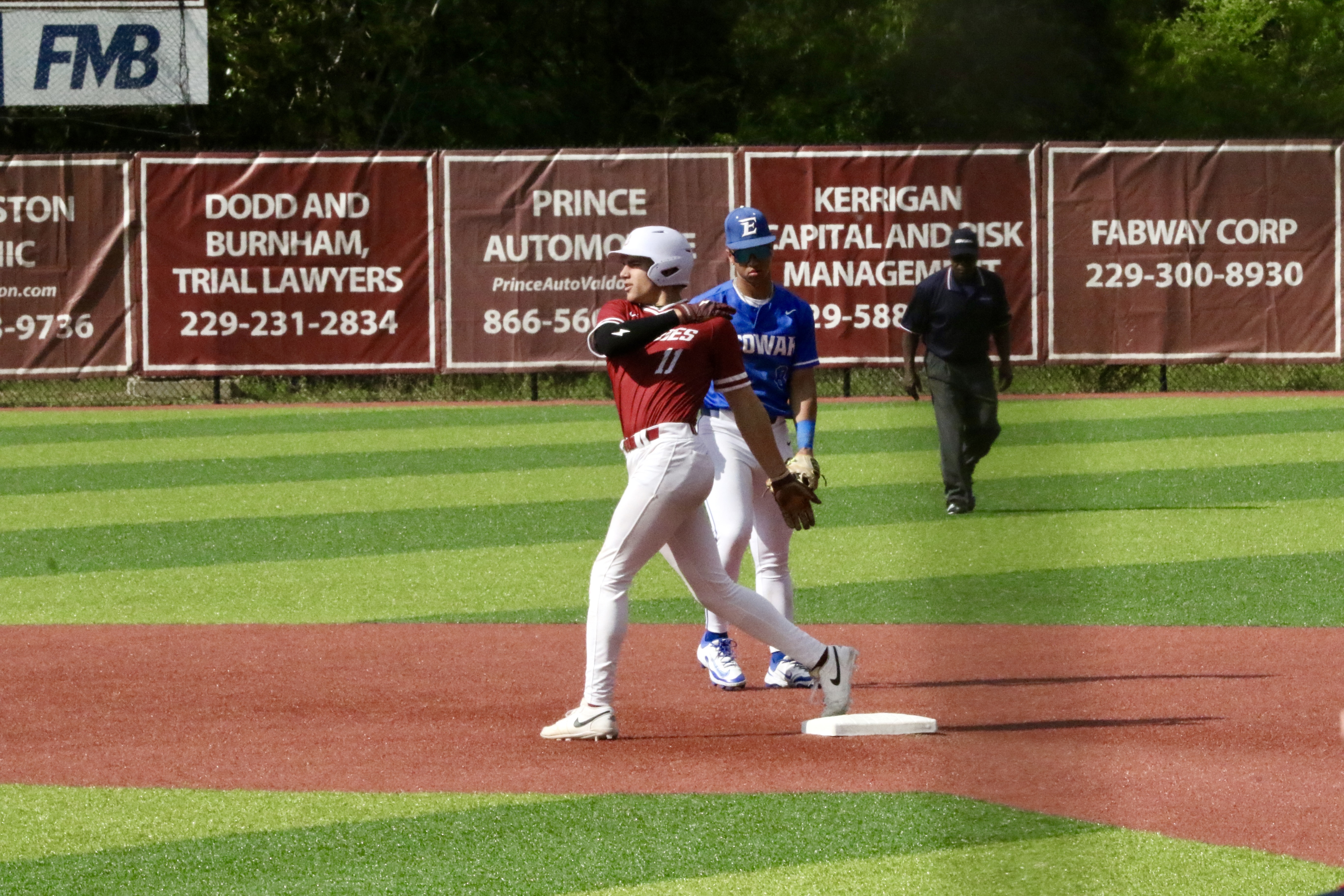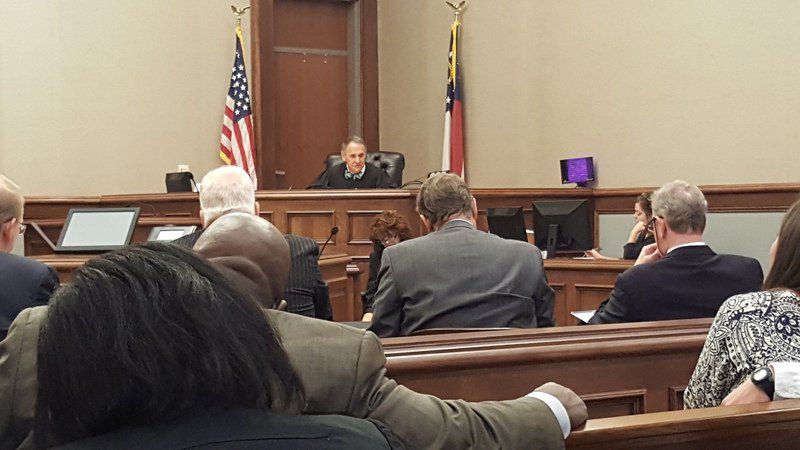Peacock murder trial headed for third day
Published 8:15 am Wednesday, June 19, 2019
MOULTRIE — The trial of a man accused of killing five friends and setting their house on fire in 2016 concluded its second day on Tuesday. The prosecution expects at least two more witnesses on Wednesday before resting its case.
Nineteen witnesses already testified in the trial of Jeffery Alan Peacock, 11 of them law enforcement officers from various agencies. Other witnesses included neighbors, friends of the deceased and one of the people who called 911 when the house at 505 Rossman Dairy Road caught fire May 15, 2016.
Inside the burning house were found the bodies of Jonathan Garrett Edwards, Ramsey Jones Pidcock and Aaron Reid Williams, all 21; Alicia Brooke Norman, 20; and Jordan Shane Croft, 22. Autopsies by the Georgia Bureau of Investigation revealed they were all shot in the head.
So far, Peacock’s defense team raised a handful of objections and cross-examined almost every witness, but it put off giving its opening arguments until it begins its part of the trial. That will come after the prosecution rests, and until then they’re offering only hints of what their strategy might be.
Separation and reconciliation
Edwards and Norman were a couple, and Williams lived with them at the residence on Rossman Dairy Road. Edwards’ signature is on the lease, which is dated October 2015, according to the landlord, Lyn Jones.
Pidcock, Croft and Peacock were their friends, and at one time Peacock lived at the house too.
Friend Mika Snipes testified Edwards had established a “no drugs” rule. When Peacock broke the rule, Edwards kicked him out. She didn’t recall a date, but she said it was about the time Peacock’s girlfriend, Memarie DiBenedetto, died; DiBenedetto’s obituary in The Moultrie Observer stated she died Feb. 7, 2016.
Another friend, Ben Littleton, said Peacock was kicked out because of drugs, but he didn’t remember the details.
In fact, Snipes said she and others were estranged from Edwards and Norman at that time. Williams remained at the house, and he helped bring the friends back together. Peacock was the last to be accepted back.
Snipes said Peacock returned to the house a few weeks before the fire. She said she assumed he was invited. Everyone was drinking as friends, she said, but after she left, Pidcock and Peacock got into a fight. She said Pidcock was trying to sleep and Peacock was “messing with him.” Pidcock, who was drunk, tried to leave and was stopped.
Her testimony wasn’t clear as to whether the fight happened because Peacock was annoying Pidcock or because he wouldn’t let him drive away drunk. In any case, on cross-examination she affirmed that the two patched up their differences soon after.
More trouble
Snipes said she was closest to Norman, and Norman had confided in her that she didn’t feel safe with Peacock at the house. The defense attorney argued that was hearsay, but state law allows an exception when the witness is describing a conversation with a person who’s now deceased (if certain other criteria are met). Superior Court Judge James Hardy agreed the prosecution had established grounds to use that exception.
Littleton faced a similar objection when he was asked to describe a conversation he had with Edwards, and his testimony was also allowed.
Littleton said Edwards wanted the friends to vote on whether to cut off Peacock as a friend. He said the vote was held Friday night, May 13, 2016, and the friends who were there seemed to be unanimous that they should stop hanging out with him. Littleton said he didn’t know whether anyone told Peacock.
Snipes didn’t testify to any such vote. She remembers that Friday night as a big party, featuring alcohol, marijuana and cocaine.
Littleton agreed there was cocaine there, but said he was only drinking. At the time he was trying to get into the military and couldn’t risk failing a drug test, he said.
“We were up all night,” Snipes said. She estimated she went home around 4 or 5 a.m.
Saturday night
On Saturday, May 14, 2016, Snipes returned to Edwards and Norman’s house in the afternoon. She said she woke up Williams and Peacock when she came in because she was arguing with her mother on the phone.
Norman came in from work a short time later then both women left separately, so Snipes said she was at the house only about 15 minutes.
Later, Peacock and Williams picked her up from her house and brought her back to the house on Rossman Dairy Road.
Snipes said the three of them plus Edwards were hanging out. Norman again had gone to bed early. Pidcock and Croft came in around 10 or 11 p.m., she said. They’d been to the river and were drunk, she said. Pidcock lay down in a chair and was soon asleep.
Snipes said Saturday night was very calm.
“There were maybe 12 beers between all of us there,” she said, adding that no one had money to get any more.
She said Peacock took her home around midnight, and everyone else was either in bed or getting ready for bed when she left.
A disturbance
In the middle of the night — around 4:30 or 5 o’clock on the morning of May 15, 2016, estimated Jorge Delacruz — he and his wife were awakened by a noise. Delacruz and his wife, Elia Rodriguez-Corona, lived in the trailer park across Rossman Dairy Road from the house where Edwards, Norman and Williams lived.
Delacruz mimicked the noise by smacking one hand with the other three times, and later by knocking on a wooden desk three times.
His wife, who testified right after him, described it like someone slamming car doors. She was afraid someone was trying to steal something or break into their mobile home.
Delacruz turned on the outside light and looked out the window but saw nothing and went back to bed.
The fire
Three calls came in to the Colquitt County E911 Center about 8:30 a.m. May 15, 2016, reporting a fire on Rossman Dairy Road. A recording of all three was played for the court on Monday, and one of the callers, Ronald “Butch” Webb, was the first witness called by the prosecution.
Webb said he saw the smoke while driving on Highway 37 and turned down Rossman Dairy Road to investigate. He pulled up in the driveway of the trailer park across the street to call 911.
“There was fire coming out the windows,” Webb recalled. “It was hot.”
While waiting for fire trucks to arrive, Webb saw a man in a green pickup truck pull up. This man was on his cell phone and after getting out of the truck, acted very distraught. Webb later learned the man was Jeffery Peacock.
Peacock was the third caller to 911 and was on the phone with them as he stood by his truck watching the house burn.
“All my buddies are inside!” he sobs on the recording of the call.
The first officer on the scene, Colquitt County Deputy Cody Green, placed Peacock in the back of his patrol car and cranked the air conditioner up to give him a chance to both cool off and calm down. Green emphasized under questioning that Peacock was not detained and was only a witness at that point.
Peacock told Green that he had spent the night at the house and had gone that morning to get breakfast for everyone. He told the same thing to Colquitt County Sheriff’s Investigator Mike Murfin about 10:30 a.m. in an interview that was also recorded and played for the court on Monday.
“I got back and the house was fully engulfed in flames,” Peacock said on the recording. “Nobody was outside.”
Story doesn’t add up
Peacock told Murfin he had needed some cigarettes so he volunteered to get everyone breakfast from Hardee’s while he was out.
With Peacock’s permission, Murfin checked the green pickup. The breakfast order was there just as Peacock said, and a pack of Marlboro 27s was in the glove compartment. But Murfin thought it was odd that several folded papers were on top of the cigarettes.
So investigators began checking his story.
They went to convenience stores along the route Peacock would take from Rossman Dairy Road to Hardee’s, and they looked at their surveillance videos.
The prosecution presented photos taken from those videos, and Murfin identified them, including reading off the time stamps. Peacock’s truck passed Circle N Petro at 8:03 a.m., followed by EZ Corner and the Best Little Store in Georgia on West Central Avenue, then American Pawn on First Avenue Southeast and finally Walgreen’s, across Veterans Parkway from Hardee’s, at 8:12 a.m.
The camera in Hardee’s drive-thru had a good video of Peacock wearing a green shirt with white lettering and khaki shorts.
Then the security cameras tracked him as he made his way back along the same path toward the residence. Time stamps on the last images are a little awkward with him passing Best Little Store at 8:27 a.m., EZ Corner at 8:28 a.m. and Circle N at 8:27 a.m. No one speculated as to why those times didn’t line up.
Missing from that, though, was a trip to BP Riverbend, another convenience store along the route. That’s where Peacock told Murfin he’d bought Marlboro 27 cigarettes on his way back from getting breakfast at Hardee’s.
Michael Cox, now a lieutenant with the Moultrie Police Department, was also a sheriff’s office investigator at the time of the fire. Part of his job in this investigation was to go through videos from Circle N and Riverbend to see when Peacock bought the cigarettes. On Monday he testified he watched recordings time-stamped from 6:30 to 9:30 the morning of the fire at Riverbend and 6:30 a.m. to 9 a.m. at Circle N without ever seeing Peacock.
On top of that, Cox said the clerk at Riverbend told him no Marlboro 27s were sold that morning.
Was the fire set?
One of the first state agencies summoned to help with the investigation was the State Fire Marshal’s Office. Investigator Don Allen led that agency’s response.
Allen testified on Monday that two of the victims were in plain sight once the fire was knocked down. The front part of the house was destroyed; even the flooring burned, leaving only the wooden frame on which the floor rested.
Assisted by Investigator Michael Crosby and his arson dog, Allen began trying to figure out what started the fire.
Allen said the fire clearly started in the front of the house and burned toward the back. But he found other spots that were heavily burned too, and with less-burned areas between them. It indicated to him that the fire started in multiple places. That made him believe the fire was set.
Crosby testified on Tuesday that his dog “hit” on five places where accelerant was used — two in the front of the house, two in the front bedroom and one on the back porch. He marked them and other investigators took samples that were sent to the GBI Crime Lab.
The defense attorneys countered that the tests on those samples did not find any accelerants — flammable substances like gasoline or kerosene that can help a fire catch hold. Allen acknowledged that.
Crosby said he had not been aware of the test results. He said the GBI lab’s equipment is calibrated to be less sensitive than the dog’s nose.
“I trust my dog,” he said.
The defense attorneys didn’t. They objected strenuously to the inclusion of Crosby’s testimony at all, arguing it wasn’t “real science” and getting Crosby to acknowledge that the dog tried to “trick him” with false positive readings.
Crosby said he knows the dog’s reactions; if he tugs on her leash, she won’t leave a real hit, but if she’s “tricking him,” she’ll come away when he pulls.
His and the dog’s certifications were entered into evidence.
The autopsies
Dr. Maryanne Gaffney-Kraft, regional medical examiner of the Central Regional Crime Lab, performed autopsies on all five victims.
All of the bodies were burned over 100 percent of their surface area, Gaffney-Kraft testified on Tuesday, but some had less damage than others. None of that affected her cause of death determination.
All five had been shot in the head.
Edwards had been shot above the right ear. The bullet was recovered from his right sinus cavity.
Norman had been shot twice in the face. Both bullets were recovered from the back of her brain.
Williams was shot behind the left ear. The bullet exited the scalp on the right side of his head and was not recovered.
Pidcock was shot in the left forehead area. The bullet was recovered from his right sinus cavity.
Croft was shot in the left forehead, but his skull suffered damage either in the fire or during recovery. Some pieces were missing, so Gaffney-Kraft could not say whether there were other entry or exit wounds. The bullet was not recovered.
Gaffney-Kraft said all the injuries would have resulted in immediate unconsciousness and quick death — Norman’s death was probably instantaneous.
Bleeding indicated the victims were alive when they were shot, Gaffney-Kraft said.
None of the victims had soot in their lungs or carbon monoxide in their blood, she said, which means none were breathing during the fire.
The prosecution did not raise the question of the toxicology report that accompanied the autopsies, but defense attorney Allan Sincox did.
Edwards had alcohol in his blood that may have been the result of his body’s decomposition; the lab couldn’t say for sure. The lab did find a metabolite of cocaine. That means Edwards had taken cocaine at some point fairly recently and his body had broken it down in preparation to excreting it, the medical examiner explained.
Norman’s test showed no alcohol, but it did show THC and its metabolites — evidence she’d used marijuana or a similar substance.
Williams showed a blood alcohol level of 0.150, and the lab test did not come with a disclaimer about decomposition, which Gaffney-Kraft indicated meant the lab specialist was confident the alcohol was consumed rather than created by decomposition. He also tested positive for THC and cocaine metabolites.
Pidcock tested negative for alcohol, but he tested positive for THC and cocaine metabolites.
Croft tested positive for alcohol but the lab said the blood sample was clotted so it couldn’t determine how much alcohol was there. He also tested positive for THC as well as for cocaine and cocaine metabolites.
Sincox asked: Since Croft had actual cocaine in his system in addition to metabolites, doesn’t that mean he had taken the drug more recently than the others, who had only metabolites?
Gaffney-Kraft said it didn’t. Drugs have a “half-life,” she explained. Cocaine’s half-life is about an hour. That means however much cocaine is in a user’s system at any given time, an hour later it’s half that. Another hour, and the amount halves again. And so on, until it dwindles to nothing.
Without knowing how much cocaine Croft had in his system to start with, she said, there’s no way to know when he consumed the drug.
The gun
GBI Special Agent Klay Luke was clearing rubble when he found a pistol in the southwest corner of the front bedroom. He identified it as a .45 caliber semiautomatic on a Model 1911 frame.
Through the course of the crime scene work, which lasted from Sunday afternoon to Friday afternoon, May 15-20, several bullets and empty casings were found.
They were submitted to the GBI Crime Lab, and firearm/toolmark examiner Catherine Jordan testified on Tuesday that several of the cartridges were fired from the gun Luke had found. Some cartridges had not been fired, she said, and had possibly gone off in the heat from the fire. Others, though, bore the distinct markings of the gun’s “fingerprint,” she said.
That includes the bullets recovered from the bodies of Edwards, Norman and Pidcock.
The gun belonged to Edwards, according to a purchase record dated March 30, 2015.
In Allen’s testimony on Monday, he mentioned a long gun found under Edwards’ body, and other testimony mentioned other calibers of ammunition being found, but Jordan said she had no knowledge of any weapons and cartridges except those related to the .45 caliber handgun and some bullet fragments that were insufficient for her to judge the caliber.
The clothing
The video taken in the Hardee’s drive-thru about 8:22 the morning of the fire shows Peacock in a green shirt with white lettering and khaki shorts.
By the time he reached the burning house on Rossman Dairy Road, he was wearing a sleeveless gray shirt and cargo shorts. A passerby, Max DeMott, caught him on a cellphone video as he drove by, and that’s the outfit Peacock was wearing when he spoke with Investigator Murfin.
The case took a turn when GBI crime scene specialist Amy Braswell and a sheriff’s office investigator searched Peacock’s truck on Monday.
Murfin, with Peacock’s permission, had looked in the truck for two specific things Sunday and stopped searching when he found them.
Colquitt County Magistrate Judge J.J. McMillan signed a search warrant for the GBI about 4:45 p.m. Sunday, and that’s when the search of the property began in earnest. It included the house, the property and all the vehicles on it, so it was the next day before investigators reached the green pickup for a more thorough search.
That’s when the sheriff’s investigator found a green shirt and khaki shorts stuffed between a large speaker box and the seat of the truck. On both were red stains that might have been blood.
Cuttings from both articles of clothing were submitted to the GBI Crime Lab to be tested both for DNA and for accelerants, Braswell said.
The results of those tests have not been revealed in court.





